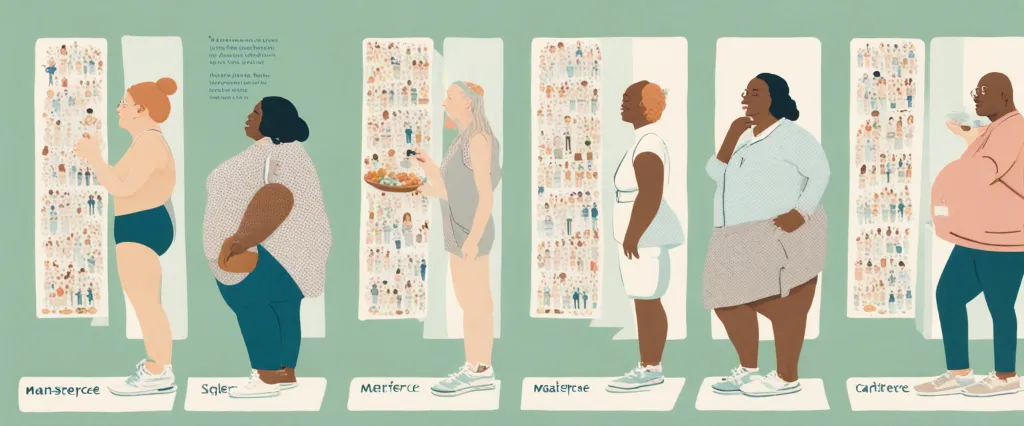In the groundbreaking book https://education.nationalgeographic.org/resource/health-every-size/”>Health at Every Size by Linda Bacon,Dr. Linda Bacon challenges the conventional beliefs surrounding weight and health, offering a refreshing and empowering perspective. Dr. Bacon, a renowned researcher and advocate, specializes in nutrition, body image, and weight-related issues. As a clinical psychologist, she has dedicated her career to understanding the complex relationship between weight, health, and well-being. With extensive academic and practical experience in the field, Dr. Bacon’s unique approach in “Health at Every Size” focuses on promoting body acceptance, healthful behaviors, and compassionate self-care, rather than pursuing weight loss as the primary goal.
Chapter 1: Introduction: Challenging weight-centric beliefs and promoting body acceptance
Chapter 1 of “Health at Every Size” by Linda Bacon sets the stage for challenging weight-centric beliefs and advocating for body acceptance. The chapter begins by highlighting society’s obsession with thinness, the diet industry’s prevalence, and the harmful effects of weight stigma and discrimination. Bacon introduces the concept of “Health at Every Size” (HAES), which promotes the idea that individuals of all body sizes can pursue health and well-being.
Bacon discusses important research findings that debunk common myths around weight and health. She explores how weight-focused approaches, such as diets and weight loss programs, have failed to deliver long-term health improvements. The author emphasizes that weight is not a reliable marker of health and that focusing on weight as the primary measure of well-being perpetuates harmful stereotypes and behaviors.
Furthermore, Bacon discusses the limitations of the Body Mass Index (BMI), which is widely used in healthcare settings. She highlights the need to move away from a weight-centric approach and instead focus on behaviors that support physical and mental well-being. The author introduces the principles of HAES, including weight inclusivity, promoting body respect, and cultivating intuitive eating and joyful movement.
The chapter concludes by stressing the importance of challenging weight-centric beliefs and promoting body acceptance to create a more inclusive and supportive environment for all individuals. Bacon asserts that HAES provides a more compassionate and evidence-supported framework for promoting health and well-being, independent of weight. By dismantling cultural ideas about body size and embracing diverse bodies, society can foster a healthier and more accepting attitude towards all individuals, promoting holistic health for everyone.
Chapter 2: Health Paradigm: Exploring the Health at Every Size approach
Chapter 2 of “Health at Every Size” by Linda Bacon delves into the concept of the Health at Every Size (HAES) approach, providing a critical exploration of the prevailing health paradigm. The chapter aims to challenge conventional beliefs that associate weight and health, while promoting a broader understanding of well-being.
Bacon highlights the flaws of the conventional health paradigm, which predominantly focuses on weight and body mass index (BMI) as indicators of health. This paradigm tends to stigmatize individuals with larger bodies and prescribe weight loss as the universal solution for health concerns. However, Bacon argues that this approach is deeply rooted in bias and fails to consider the diverse factors that contribute to overall health.
The HAES approach, on the other hand, views health as a multidimensional concept and acknowledges that bodies naturally come in various sizes. It recognizes the importance of adopting healthy behaviors that are not solely focused on weight loss but rather on promoting overall well-being. The chapter emphasizes the need to shift the focus from weight to healthy behaviors, such as engaging in enjoyable physical activity and practicing self-care.
Bacon presents evidence indicating that weight-focused approaches have proven to be largely unsuccessful in achieving long-term weight loss for the majority of individuals. Furthermore, these approaches often result in negative mental and physical health consequences, including disordered eating and body dissatisfaction.
Overall, Chapter 2 introduces the HAES paradigm as an alternative and more compassionate approach to health and weight. It encourages readers to challenge societal weight biases, embrace body diversity, and prioritize individual well-being and self-acceptance over weight-centric goals.
Chapter 3: Body Acceptance: Embracing diverse body shapes and sizes
Chapter 3 of “Health at Every Size” by Linda Bacon focuses on the concept of body acceptance and the importance of embracing diverse body shapes and sizes. Bacon argues that society’s obsession with weight and promoting a specific ideal body shape contributes to body discrimination, low self-esteem, and a myriad of health-related issues.
The chapter begins by challenging the notion that weight is the sole determining factor of a person’s health. Bacon highlights that there is a wide range of body shapes and sizes that can be healthy and thriving, and that health should not be defined solely by weight or appearance.
Bacon emphasizes that body acceptance is crucial for individuals to develop a healthy relationship with their bodies. She advocates for viewing bodies as diverse and unique, each with different genetic factors and environmental influences. By embracing these variations, people can focus on self-care and overall well-being rather than aiming for a specific weight or shape that may be unrealistic or harmful.
The author discusses the harmful effects of weight stigma and the importance of breaking free from society’s narrow definition of beauty. She encourages individuals to reject the idea that their worth is determined by their appearance and to embrace body diversity instead. This involves challenging negative beliefs and biases about bodies, both for oneself and others.
Bacon emphasizes the importance of self-compassion and self-acceptance, promoting practices such as intuitive eating and mindful movement. By listening to one’s body and nurturing it with respect and care, individuals can enhance their overall well-being and reconnect with their innate sense of body wisdom.
In summary, Chapter 3 of “Health at Every Size” advocates for body acceptance and the celebration of diverse body shapes and sizes. By rejecting societal ideals, people can develop healthier relationships with their bodies, prioritize self-care, and focus on overall well-being rather than weight or appearance.
Chapter 4: Nutrition: Honoring hunger and fullness cues for balanced eating

Chapter 4 of “Health at Every Size” by Linda Bacon is titled “Nutrition: Honoring Hunger and Fullness Cues for Balanced Eating.” In this chapter, Bacon emphasizes the importance of listening to our body’s natural hunger and fullness cues to achieve balanced and healthy eating habits.
Bacon introduces the concept of intuitive eating, which involves trusting our body’s signals of hunger and fullness rather than relying on external rules or restrictions. She discusses the negative consequences of dieting, such as disordered eating patterns and the loss of connection with our body’s signals. Embracing intuitive eating allows individuals to develop a healthy relationship with food, promoting long-term physical and emotional well-being.
The chapter highlights the significance of honoring hunger cues by eating when truly hungry and not relying on numbers or external factors to dictate when and how much to eat. Bacon encourages readers to eat a variety of foods to ensure adequate nutrition, while not depriving oneself of enjoyable foods.
Similarly, honoring fullness cues is crucial for balanced eating. Bacon explains the importance of eating until satisfied, not until overly full. By paying attention to our body’s satiety signals, we can prevent overeating and promote overall wellness.
Bacon also addresses the misconception that weight is a direct indicator of health. She challenges the prevailing belief that thinness is synonymous with good health, emphasizing that health can be achieved and maintained at any size. By shifting the focus from weight to overall well-being, individuals can prioritize self-care and body acceptance.
In summary, Chapter 4 of “Health at Every Size” emphasizes the importance of honoring hunger and fullness cues for balanced eating. By embracing intuitive eating, individuals can develop a positive relationship with food, without relying on external rules or restrictions. Bacon encourages readers to trust their body’s signals, eat a variety of foods, and prioritize overall well-being over weight.
Chapter 5: Physical Activity: Encouraging joyful movement and fitness for all
In Chapter 5 of the book “Health at Every Size” by Linda Bacon, the focus is on physical activity and how to foster joyful movement and fitness for everyone, regardless of body size.
The chapter begins by debunking the myth that exercise is solely for weight control, emphasizing that it is an essential component of overall well-being. It emphasizes that weight loss should not be the primary goal of physical activity, as research consistently shows that it is ineffective and often leads to negative health outcomes. Instead, the focus should be on enjoying and embracing movement in ways that feel good to each individual.
Bacon argues that exercise should be about joy, pleasure, and celebration of the body’s capabilities, rather than a punishment or obligation. The author encourages readers to find activities they genuinely enjoy, whether it’s dancing, hiking, swimming, or any other form of movement that brings happiness and fulfillment. The key is to reject societal expectations and stereotypes around what exercise should look like and instead find ways to make movement a part of everyday life.
Furthermore, the chapter highlights the importance of incorporating intuitive movement, which involves listening to the body’s needs and preferences. This approach encourages individuals to trust their internal cues of hunger, fullness, and fatigue, allowing them to engage in physical activity that aligns with their unique abilities and desires.
The chapter concludes by emphasizing the benefits of adopting a Health at Every Size approach to physical activity. By shifting the focus from weight loss to overall well-being and enjoyment, individuals can cultivate a positive relationship with movement, leading to improved physical and mental health outcomes for people of all body sizes.
Chapter 6: Mental Health: Addressing body image issues and promoting self-care
Chapter 6 of “Health at Every Size” by Linda Bacon focuses on mental health and how it relates to body image issues and self-care. The chapter highlights the negative impact of societal pressures on body ideals and the importance of cultivating a positive body image for overall well-being.
Bacon emphasizes that the obsession with achieving a specific body shape or size is deeply ingrained in our culture and contributes significantly to mental health problems such as anxiety, depression, and eating disorders. Society’s narrow definition of beauty often leads to low self-esteem, body dissatisfaction, and a constant feeling of inadequacy.
To address these issues, the chapter explores strategies for promoting self-care and improving body image. It encourages readers to adopt a compassionate attitude towards their bodies and challenge societal norms. Bacon emphasizes the importance of embracing body diversity and recognizing that all bodies are valuable, regardless of their shape or size.
The chapter suggests various practices for self-care and improving mental health. This includes finding activities that bring joy, such as engaging in hobbies or taking part in physical movement that is enjoyable rather than focused on weight loss. It also emphasizes the significance of self-compassion, practicing mindfulness, and building a support network of like-minded individuals who promote body positivity.
Overall, Chapter 6 of “Health at Every Size” encourages readers to prioritize mental health by addressing body image issues and promoting self-care. By challenging societal beauty standards, embracing body diversity, and engaging in activities that promote well-being, individuals can develop a healthier and more positive mindset towards their bodies.
Chapter 7: Social Justice: Recognizing weight stigma and advocating for inclusivity
Chapter 7 of the book “Health at Every Size” by Linda Bacon focuses on the concept of social justice in relation to weight stigma and the importance of advocating for inclusivity. Bacon highlights the pervasive issue of weight discrimination and how it impacts the health and well-being of individuals who do not conform to society’s narrow standards of beauty and thinness.
The chapter starts by emphasizing that weight stigma affects individuals of all sizes, and it is not solely a matter of health or self-control. Bacon argues that promoting inclusivity and combating weight stigma are essential for creating a more just and equitable society. She acknowledges that weight discrimination is deeply entrenched in our culture, appearing in various domains such as healthcare, media, education, and employment.
Bacon presents evidence demonstrating that weight stigma harms both physical and mental health, leading to increased risk of chronic diseases, psychological distress, and even higher mortality rates. The author challenges the commonly held belief that shame and blame are effective motivators for weight loss, instead advocating for a compassionate and inclusive approach to health.
The chapter further discusses the need for a weight-inclusive perspective within the healthcare system. Bacon highlights the importance of practitioners adopting a respectful and non-judgmental attitude towards all bodies, emphasizing health-promoting behaviors over weight loss as the focus of care. She also provides strategies for individuals to become advocates for inclusivity, suggesting ways to challenge weight bias and support social justice movements that fight against weight stigma.
In conclusion, Chapter 7 of “Health at Every Size” emphasizes the significance of recognizing weight stigma and advocating for inclusivity to create a more just society. Bacon argues that weight discrimination harms both physical and mental health and supports adopting a weight-inclusive approach in healthcare and everyday life. The chapter encourages individuals to challenge weight bias and work towards social change.

Chapter 8: Sustainable Change: Implementing long-term habits for holistic well-being
Chapter 8 of “Health at Every Size” by Linda Bacon focuses on sustainable change and the implementation of long-term habits for holistic well-being. The chapter emphasizes the importance of adopting healthy habits that prioritize physical, mental, and emotional health, rather than focusing solely on weight or body size.
Bacon argues that diets and weight-focused approaches often fail to bring sustainable change because they primarily focus on external changes rather than addressing the underlying causes of health conditions. She suggests that it is crucial to explore the true motivations behind wanting to improve health and well-being, aiming to create positive changes from a place of self-compassion and self-care.
The chapter further emphasizes the significance of setting realistic and attainable goals. Bacon encourages readers to focus on small, gradual changes that can be maintained in the long run, rather than adopting drastic, short-term measures that often lead to yo-yo dieting. By making sustainable changes, individuals can create long-lasting habits that support their overall well-being.
Bacon also underscores the importance of developing a strong support system, as social support has been found to be crucial in maintaining healthy habits. Surrounding oneself with individuals who promote self-acceptance, body positivity, and health at every size can greatly contribute to sustaining positive changes.
In conclusion, Chapter 8 of “Health at Every Size” highlights the necessity of implementing sustainable changes for holistic well-being. By focusing on self-care, setting realistic goals, and cultivating a supportive environment, individuals can establish long-term habits that prioritize their physical, mental, and emotional health, rather than fixating on weight or body size.
After Reading
In conclusion, “Health at Every Size” by Linda Bacon challenges traditional notions of health and weight by advocating for a paradigm shift towards body acceptance and holistic wellbeing. Bacon’s groundbreaking research and practical insights highlight the dangers of weight-centric approaches to health, emphasizing the importance of listening to our bodies and engaging in joyful movement. By debunking diet culture myths and promoting self-compassion, the book offers a powerful framework for cultivating a positive relationship with our bodies and prioritizing our overall wellbeing, regardless of size. With an emphasis on inclusivity and respect for diverse experiences, “Health at Every Size” serves as an essential guide for anyone seeking to reclaim their health and happiness from society’s restrictive standards.
1. “The Body Is Not an Apology: The Power of Radical Self-Love” by Sonya Renee Taylor – This book challenges societal beauty standards and promotes body positivity through radical self-love and acceptance. It explores the intersections of body image, race, sexuality, and disability, making it a compelling read for those seeking liberation from cultural norms.
2. “Big Fit Girl: Embrace the Body You Have” by Louise Green – This empowering memoir encourages readers to embrace their bodies and involve them in fitness pursuits, breaking away from the misconception that only thin bodies can be fit. With her personal story and practical advice, Green inspires women of all sizes to reclaim their health and happiness.
3. “Body of Truth: How Science, History, and Culture Drive Our Obsession with Weight—and What We Can Do About It” by Harriet Brown – In this meticulously researched book, Brown delves into the complex and often harmful obsession with weight loss in our society. Packed with eye-opening facts and personal stories, the author challenges the diet industry and offers practical alternatives to achieve a healthy relationship with our bodies.
4. “Intuitive Eating: A Revolutionary Program That Works” by Evelyn Tribole introduces a transformative approach to food and eating. It empowers readers to listen to their body’s cues, reject diet culture, and develop a healthy and intuitive relationship with food, leading to improved well-being and a positive body image.
5. “Body Respect: What Conventional Health Books Get Wrong, Leave Out, and Just Plain Fail to Understand about Weight” by Linda Bacon challenges societal norms and provides a compassionate and evidence-based approach to body acceptance and health. It promotes a paradigm shift away from weight-focused thinking and encourages self-care and self-acceptance.




